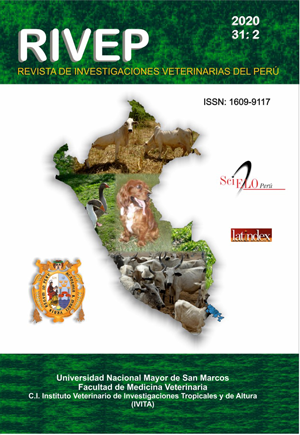Morphometric and functional analysis of bovine oocytes obtained from abattoir ovaries and by transvaginal follicle aspiration in creole cows of the Ecuadorian Andean highland
DOI:
https://doi.org/10.15381/rivep.v31i2.17838Keywords:
indigenous cows, oocytes, morphometry, BCB, viabilityAbstract
This study assessed the morphometric and functional characteristics of oocytes from 10 native cows to the Ecuadorian Andes, collected by transvaginal follicular aspiration (OPU) and oocytes collected post mortem (PM) from abattoir ovaries. For this purpose, 1157 cumulus-oocyte complexes (CCOs) of the OPU group (n=271) and PM group (n=886) were recovered in 10 repetitions per group by follicular aspiration at 90 mm Hg pressure and classified as A, B or C, according to the characteristics of the cytoplasm and cumulus cells. The activity of the enzyme glucose 6 phosphate dehydrogenase (G6PD) was determined as an indicator of follicular growth and maturation and the integrity of the plasma membrane by staining the CCOs with cresyl brilliant blue (BCB +) and trypan blue, respectively. The size (diameter and volume) of the oocytes was evaluated using CaptaVisio® software v. 5.1. The data were analysed by logistic regression and by the SAS general linear model, and the means were compared by the least square method. The results showed that the oocytes of the PM group had a larger diameter (126.0 ± 0.48 vs. 122.7 ± 0.79 µm; p<0.01) and integrity of the plasma membrane (86.0 vs. 76.8%; p<0.05) than the OPU group. However, quality A and B oocytes did not show significant differences between groups with respect to plasma membrane integrity and BCB + values. The results suggest that, although the fact that the size and viability were more affected in the oocytes aspirated by OPU, those of quality A and B from both sources showed similar values regarding the integrity of the plasma membrane and metabolic condition to continue. maturation.
Downloads
Downloads
Published
Issue
Section
License
Copyright (c) 2020 Jhonatan Alvarado U., Daniel Argudo G., Ulises Iñiguez G., Patricio Bueno L., Maria Silvana Méndez A., Manuel Soria P., Fernando P. Perea G., Diego Andres Galarza L.

This work is licensed under a Creative Commons Attribution-NonCommercial-ShareAlike 4.0 International License.
AUTHORS RETAIN THEIR RIGHTS:
a. Authors retain their trade mark rights and patent, and also on any process or procedure described in the article.
b. Authors retain their right to share, copy, distribute, perform and publicly communicate their article (eg, to place their article in an institutional repository or publish it in a book), with an acknowledgment of its initial publication in the Revista de Investigaciones Veterinarias del Perú (RIVEP).
c. Authors retain theirs right to make a subsequent publication of their work, to use the article or any part thereof (eg a compilation of his papers, lecture notes, thesis, or a book), always indicating the source of publication (the originator of the work, journal, volume, number and date).










